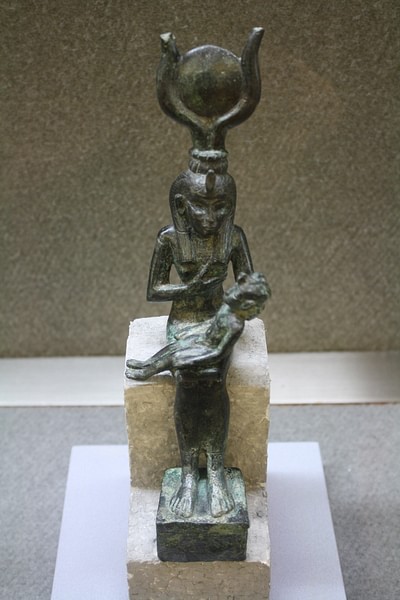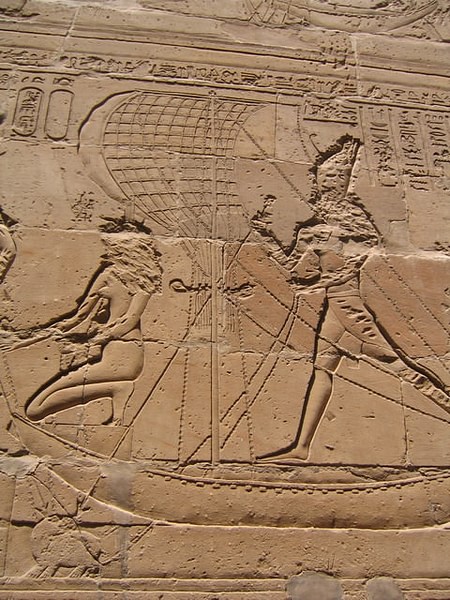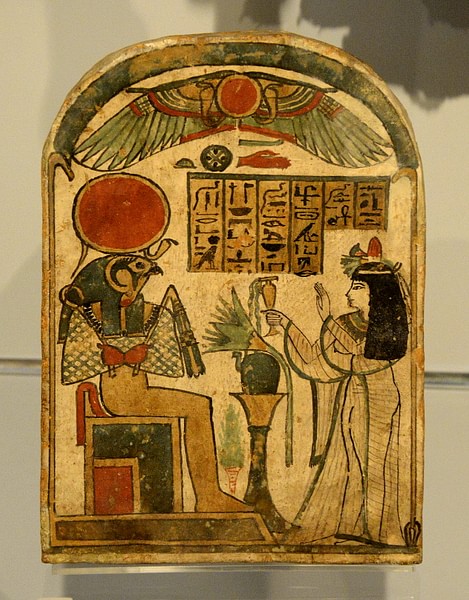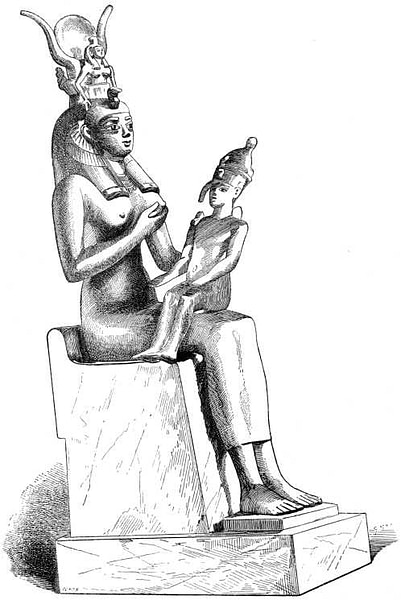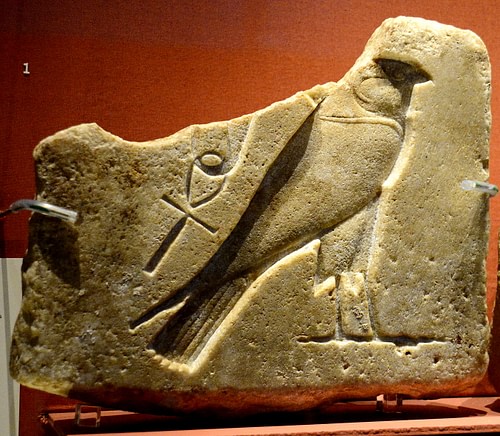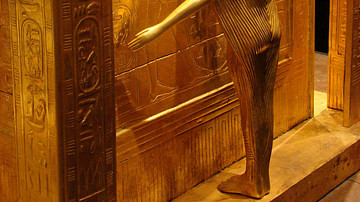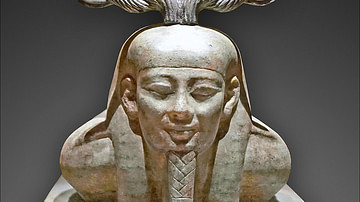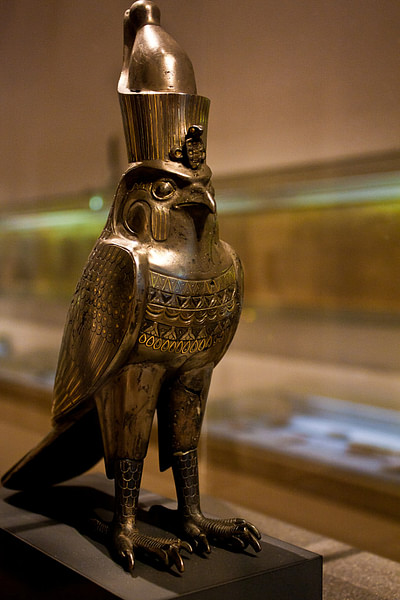
Horus is the name of a sky god in ancient Egyptian mythology which designates primarily two deities: Horus the Elder (or Horus the Great), the last born of the first five original gods, and Horus the Younger, the son of Osiris and Isis.
According to the historian Jimmy Dunn, "Horus is the most important of the avian deities" who takes on so many forms and is depicted so differently in various inscriptions that "it is nearly impossible to distinguish the 'true' Horus. Horus is mostly a general term for a great number of falcon deities" (2). While this is certainly true, the name 'Horus' will usually be found to designate either the older god of the first five or the son of Isis and Osiris who defeated his uncle Set and restored order to the land.
The name Horus is the Latin version of the Egyptian Hor which means "the Distant One", a reference to his role as a sky god. The elder Horus, brother of Osiris, Isis, Set, and Nephthys, is known as Horus the Great in English or Harwer and Haroeris in Egyptian. The son of Osiris and Isis is known as Horus the Child (Hor pa khered) who was transformed into the Greek god Harpocrates after Alexander the Great conquered Egypt in 331 BCE. 'Harpocrates' also means 'Horus the Child' but the deity differed from the Egyptian Horus. Harpocrates was the Greek god of silence and confidentiality, the keeper of secrets, whose statuary regularly depicts him as a winged child with his finger to his lips.
Horus the Younger, on the other hand, was a powerful sky god associated with the sun, primarily, but also the moon. He was the protector of the royalty of Egypt, avenger of wrongs, defender of order, uniter of the two lands and, based on his battles with Set, a god of war regularly invoked by Egyptian rulers before battle and praised afterwards. In time, he became combined with the sun god Ra to form a new deity, Ra-Harahkhte, god of the sun who sailed across the sky during the day and was depicted as a falcon-headed man wearing the double crown of Upper and Lower Egypt with the sun disk on it. His symbols are the Eye of Horus (one of the most famous Egyptian symbols) and the falcon.
Horus the Elder
The elder Horus is one of the oldest gods of Egypt, born of the union between Geb (earth) and Nut (sky) shortly after the creation of the world. His older brother Osiris was given the responsibility of governing the earth along with Isis while Horus was given charge of the sky and, specifically, the sun. In another version of the story, Horus is the son of Hathor while, in others, she is his wife and, sometimes, she is mother, wife, and daughter of Horus. The scholar Geraldine Pinch notes that "one of the earliest divine images known from Egypt is that of a falcon in a barque" representing Horus in the sun barge traveling across the heavens (142). Horus is also depicted as a creator god and benevolent protector.
There were many falcon gods (known as Avian Deities) in Egyptian religion who were eventually absorbed into the god known as Horus. Some, such as Dunanwi from Upper Egypt, appear early in history while others, like Montu, were popular later. Horus' early association with Dunanwi has been challenged by scholars but there is no doubt he was later combined with the god as Horus-Anubis. Dunanwi was a local god of the 18th upper nome (province) while Horus was widely worshipped throughout the country. It is possible that, like Inanna in Mesopotamia, the figure of Horus began as a local god such as Dunanwi but it seems more likely that Horus was fully realized early in Egypt's religious development.
Egyptologist Richard H. Wilkinson comments on how "Horus was one of the earliest of Egyptian deities. His name is attested from the beginning of the Dynastic Period and it is probable that early falcon deities such as that shown restraining the `marsh dwellers' on the Narmer Palette represent this same god" (200). Rulers of the Predynastic Period in Egypt (c. 6000-3150 BCE) were known as "Followers of Horus" which attests to an even earlier point of veneration in Egypt's history.
In his role as The Distant One he performs the same task as The Distant Goddess, a function associated with Hathor (and a number of other female deities) who go forth from Ra and return, bringing transformation. The sun and the moon were considered Horus' eyes as he watched over the people of the world day and night but could also draw near to them in times of trouble or doubt. Imagined as a falcon, he could fly far from Ra and return with vital information and, in the same way, could quickly bring comfort to those in need.
From the Early Dynastic Period (c. 3150-c.2613 BCE) onwards, Horus was linked with the king of Egypt (though later rulers associated themselves with Horus the Younger). Historian Margaret Bunson writes, "The Serekh, the earliest of the king's symbols, depicted a falcon (or hawk) on a perch. As a result, devotion to Horus spread throughout Egypt but in various locales the forms, traditions, and rituals honoring the god varied greatly" (116). This variation gave rise to a number of different epithets and roles for this deity and eventually led to his transformation from the elder Horus to the child of Osiris and Isis.
Horus the Younger & The Osiris Myth
The younger Horus is sometimes mentioned as related to the older god but quickly eclipsed him and assumed many of his characteristics. By the time of the Ptolemaic Dynasty (323-30 BCE), the last dynasty to rule Egypt, the elder Horus had been completely replaced by the younger. Statues of Horus the Child from the Ptolemaic period show him as a young boy with his finger to his lips perhaps representing the time when he had to remain quiet when hiding from his uncle Set as a child. In his young form he "came to represent a promise by the gods to take care of suffering humanity" since he had himself suffered as an child and knew how it felt to be fragile and surrounded by dangers (Pinch, 147). It was this form of Horus who would become the Greek Harpocrates whom Plutarch called "the second son of Isis" and who would go on to become popular in the Roman world. The Cult of Isis was the most popular mystery cult in Rome, greatly influencing the development of Christianity, and Harpocrates was the divine son depicted in ancient Roman art with his mother.
The story of Horus comes out of the Osiris Myth which was one of the most popular in ancient Egypt and gave rise to the Cult of Isis. This story begins shortly after the creation of the world when Osiris and Isis ruled over a paradise they created. When men and women were born from the tears of Atum (Ra) they were uncivilized and barbaric. Osiris taught them culture, religious observances to honor the gods, and the art of agriculture. The people were all equal at this time, men and women, owing to the gifts of Isis which were dispensed to all. Food was plentiful and there was no want or need unfulfilled.
Osiris' brother, Set, grew jealous of him and this envy turned to hatred when Set discovered that his wife, Nephthys, had transformed herself into the likeness of Isis and seduced Osiris. Set was not angry with Nephthys, however, but focused his revenge on his brother, "The Beautiful One", who had presented a temptation too strong for Nepthys to resist. Set tricked Osiris into laying down in a casket he had made to his brother's exact specifications and, once Osiris was inside, Set slammed the lid on and threw the box into the Nile.
The casket floated down the river to eventually lodge in a tamarisk tree by the shores of Byblos where the king and queen admired its beauty and sweet scent and had it cut down for a pillar in their court. While this was going on, Set has usurped Osiris' rule and reigned over the land with Nephthys. He neglected the gifts which Osiris and Isis had bequeathed and the land suffered drought and famine. Isis knew she had to bring Osiris back from wherever Set had banished him to and went out searching for him. She finally found him inside the tree-pillar at Byblos, asked the king and queen for it, and brought it back to Egypt.

Osiris was dead but Isis knew she could bring him back to life. She asked her sister Nephthys to stand guard over the body and protect it from Set while she went to gather herbs for potions. Set, meanwhile, had heard that his brother had returned and was out looking for him. He found Nephthys and tricked her into telling him where the body was hidden; then he hacked Osiris into pieces and scattered the body parts across the land and into the Nile. When Isis came back she was horrified to find her husband's body missing. Nephthys told her how she had been tricked and what Set had done to Osiris.
The two sisters then went in search of the body parts and reassembled Osiris. His penis had been eaten by a fish and so he was incomplete but Isis could still return him to life. Isis used her magic and potions and, in some versions of the story, is aided in this by Nephthys. Osiris revived but could no longer rule among the living because he was no longer whole; he would have to descend to the underworld and reign there as Lord of the Dead. Prior to his departure, though, Isis transformed herself into a kite (a falcon) and flew around his body, drawing his seed into her own and becoming pregnant with Horus. Osiris left for the underworld and Isis went into hiding in the Delta region of Egypt to protect herself and her son from Set.
Horus & Isis
Isis endured a difficult pregnancy with exceptionally long labor and gave birth to Horus alone in the swamps of the Delta. She hid herself and her son from Set and his demons in the thickets, only going out at night for food accompanied by a bodyguard of seven scorpions who were given her by the goddess Selket. Selket (and, in some versions of the story, Neith) watched over Horus while Isis went out. Isis, Selket, and Neith nurtured Horus and educated him in their exile until he was grown to manhood and was strong enough to challenge his uncle for his father's kingdom.
The story of the battles between Horus and Set have many different versions but the best known is from a manuscript dating to the 20th Dynasty (1090-1077 BCE), The Contendings of Horus and Set which describes their contest as a legal trial in front of the Ennead, a tribunal of nine powerful gods. In this version of the story, Horus brings a complaint against Set - who is one of the nine - claiming he has unlawfully taken the throne from Osiris - who is also one of the nine judges.
The tribunal is asked to decide between Horus and Set and most of the gods choose Horus but Ra, the supreme god, claims that Horus is too young and inexperienced and Set has the better claim to rule. Horus and Set must compete in a series of battles to prove which is best able to reign. In the course of these battles, Horus loses an eye and Set is castrated (or, at least, severely damaged) but Horus is victorious each time.
These contests go on for over 80 years and Ra continues to deny Horus his right to the throne. Meanwhile, the land is suffering under Set's rule and Isis is desperate to do something to help her son and her people. She transforms herself into a beautiful young woman and sits down in front of Set's palace where she begins to cry. When Set comes out and sees her, he asks the cause of her sorrow and she tells him how a wicked man, her husband's own brother, has killed him and taken his land and, further, seeks the life of her only son and has banished her to the swamp lands and the thickets where only the scorpions are her companions.
Set is outraged by her story and declares that this man should be punished. He swears that he, himself, will go find this man and cast him from the lands and restore the woman and her child to their rightful place. Isis then throws off her disguise and reveals herself and the other gods in attendance. Set has condemned himself by his own decree and Ra agrees with the other gods that Horus should be king. Set is then banished to the desert lands beyond Egypt's borders while Horus assumes the throne of his father with his mother and aunt Nephthys as consorts.
In another version of the story, the trial lasts for 80 years until the frustrated gods turn to the wise goddess Neith, mediator of disputes, who rules in favor of Horus. She suggests that Set be given reign of the desert regions while Horus rules the fertile Nile River Valley. As a consolation, she proposes, Set should also be given two foreign goddesses as consorts - the warrior-goddess Anat from Syria and Astarte, the Queen of Heaven, from Phoenicia. This version of the story explained how Set came to be associated with people of foreign lands as well as the desert regions.
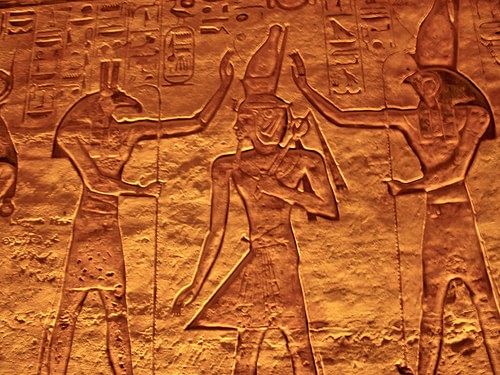
Horus & the King
Having conquered Set and restored order, Horus became known as Horu-Sema-Tawy, The Horus, Uniter of the Two Lands. He reinstated the policies of his parents, rejuvenating the land, and ruled wisely. It is for this reason that kings of Egypt, from the First Dynastic Period on, aligned themselves with Horus and chose a "Horus Name" to rule under at their coronation. Osiris had been the first king of Egypt who established order and then passed on to the underworld while Horus was the king who restored that order after it was overturned by Set and who raised Egypt up from chaos to harmony.
Egyptian kings, therefore, identified themselves with Horus in life and Osiris in death. During their reign, they were the physical manifestation of Horus under the protection of Isis (a notable departure from this custom being the king Peribsen, sixth king of the Second Dynasty, who aligned himself clearly with Set). Ramesses II famously invokes the protection of Isis and Horus in his Poem of Pentaur following the Battle of Kadesh in 1274 BCE as do many other kings and pharaohs of Egypt. Wilkinson writes:
Horus was directly linked with the kingship of Egypt in both his falcon form aspect and as son of Isis. From the earliest Dynastic Period the king's name was written in the rectangular device known as the serekh which depicted the Horus falcon perched on a stylized palace enclosure and which seems to indicate the king as mediator between the heavenly and earthly realms, if not the god manifest within the palace as the king himself. To this "Horus Name" of the monarch, other titles were later added, including the "Golden Horus" name in which a divine falcon is depicted upon the hieroglyphic sign for gold. (201)
Since the king of Egypt was the `great house' who protected his people, all the citizens of Egypt were under the protection of Horus. He was worshipped in many forms and in many different sites. Wilkinson notes that, "Horus was worshipped along with other deities in many Egyptian temples and imporant sites of his worship are known from one end of Egypt to the other" (203). His importance as the uniter of the two lands and maintainer of order made him a representation of the concept of balance which was highly valued by the Egyptians.
Worship of Horus
Horus was worshipped in the same way as any of the other gods of Egypt: temples were built as homes for the god and his statue placed within the inner sanctum where only the chief priest was allowed to attend him. The clergy of the Horus Cult were always male as they associated themselves with Horus and claimed protection from their `mother' Isis. Attendant priests took care of the temple complex which, like any other, was constructed to mirror the afterlife of the Field of Reeds. The reflecting pool of the temple was Lily Lake (also known as The Lake of Flowers) which the souls of the justified dead were rowed across by the divine ferryman Hraf-hef (`He-Who-Looks-Behind-Himself'). The temple was the afterlife palace and home of the god and the courtyard, decorated with flowers, was his garden.
The Four Sons of Horus
This protection extended through life and beyond death. Horus was associated with the afterlife through his Four Sons who protected the vital organs of the deceased. These four gods represented the four cardinal points of the compass and each was presided over and protected by a goddess. The Four Sons of Horus were:
- Duamutef - a jackal god who protected the stomach, represented the east, and was protected by Neith.
- Hapy - a baboon god who protected the lungs, represented the north, and was protected by Nephthys.
- Imsety - a god in human form who protected the liver, represented the south, and was protected by Isis.
- Qebehsenuef - a hawk god who protected the intestines, represented the west, and was protected by Selket.
These organs were held in canopic jars which sometimes had the head of the protector-god as the lid handle. The most famous example of the canopic protectors is the alabaster artifact from the tomb of Tutankhamun in which Isis, Neith, Nephthys, and Selket are carved. All four of the protector-gods were depicted as mummified men with their respective different heads of jackal, baboon, human, and hawk. These were all seen as manifestations of Horus who was a friend to the dead. Horus was invoked at funerals for protection and guidance for those who had departed and for the living who remained behind.
Horus & Jesus Controversy
The Cult of Horus in Egypt, as noted, was already ancient by the time the Osiris Myth became popular and that myth elevated the worship of Osiris, Isis and Horus to a national level. The Cult of Isis became so popular that worship of the goddess traveled through trade to Greece and then to Rome where it became the greatest challenge to the new religion of Christianity in the 3rd-5th centuries CE. Horus traveled with her in the form of Horus the Child and influenced Christian iconography of the Virgin Mary and the Christ Child.
There is no doubt the woship of Isis influenced early Christianity through the concepts of the Dying and Reviving God who returns from the dead to bring life to the people, eternal life through dedication to that god, the image of the virgin mother and child, and even the red-hue and characteristics of the Christian devil. This is not to say, however, that Christianity is simply the Isis Cult re-packaged nor that Horus was the prototype for the risen Christ.
The book The Pagan Christ by Tom Harpur (2004) makes this very claim, however, and has given rise to the so-called Horus-Jesus Controversy also known as the Son of God Controversy. Harpur claims that Christianity was invented wholly from Egyptian mythology and that Jesus Christ is simply Horus re-imagined. To support his claim, Harpur cites `experts' on the subject such as Godfrey Higgins, Gerald Massey, and Alvin Boyd Kuhn, all writers from the 18th, 19th, and 20th centuries, none of whom were biblical scholars or Egyptologists. Higgins was an English magistrate who believed all religions came from the Lost City of Atlantis; Massey, a self-styled Egyptologist, was an English spiritualist who studied available inscriptions at the British Museum; Kuhn was a self-published author whose primary focus was promoting his Christ Myth Theory which was essentially just a re-write of the work done by Higgins and Massey.
Harpur presents these `experts' as though they had uncovered something miraculous and unheard of when, in reality, their observations are often innacurate re-treads of earlier works (such as those of Epictetus and Marcus Aurelius) or wildly speculative theories presented as though they are brilliant insights. The Dying and Reviving God motif had existed for thousands of years before the apostle Paul began is evangelical efforts c. 42-62 CE and the concept of eternal life through personal dedication to a god was equally well established. Harpur's book presents a number of very serious problems to any reader acquainted with the Bible, Christianity, and Egyptian Mythology and history but his most serious offense is the claim that Horus and Jesus share "remarkable similarities".
This claim, which is quite obviously false to anyone who knows the stories of the two figures, has become the best known of the book. Unfortunately, many readers who do not know the original stories take Harpur's claims as legitimate scholarship when they are not. To cite only a few examples, Harpur asserts that both Horus and Jesus were born in a cave - this is false, Horus was born in the Delta swamps and Jesus in a stable; both births were announced by an angel - also false, as the concept of the angel, a messenger of God, is absent from Egyptian beliefs; Horus and Jesus were both baptized - false, baptism was not practiced by Egyptians; both Horus and Jesus were tempted in the wilderness - false, Horus battled Set in many different regions, including the arid desert while the gospel stories make clear that Jesus was tempted in the desert or the wilderness; Horus and Jesus were both visited by Three Wise Men - false, Horus is never visited by wise men and, even more damaging to Harpur's 'scholarship', there are not 'three wise men' mentioned in the Bible which only references `wise men' who bring three kinds of gifts; Horus and Jesus both raised the dead back to life - false, Horus had nothing to do with raising Osiris or anyone else from the dead.
Horus the Redeemer
All of Harpur's further claims are equally untenable owing to extremely poor scholarship and a reliance on sources which are not credible. Neither Horus nor Jesus benefit from his shoddy comparison of their lives. The concept of Horus as redeemer was well established in Egypt but this does not necessarily mean that concept was exclusive to him nor that there were not other `redeemers' in between the time of the popularity of Horus and the development of Christianity. Horus was a redeemer of health and humans in their earthly form; not of souls needing salvation from sin and eternal punishment. Horus the Child was one of a number of so-called 'child gods' of ancient Egypt who appeared in the form known as Shed (Savior) but was a savior from earthly troubles, not eternal ones. Geraldine Pinch writes:
He appeared on stelae of the late New Kingdom dressed as a prince who vanquished dangerous animals with his bow or curved sword. This was a forerunner of the type of magical stela known as a cippus. On these, the naked Horus child tramples on crocodiles and squeezes the life out of other dangerous creatures such as snakes, lions, and antelopes. When the Greeks saw such objects, they identified Horus the Child/Harpocrates with the infant Herakles (Hercules) who strangled two snakes that attacked him in his cradle. (147)
Horus also, through his Four Sons, watched over and was a friend to the dead but was primarily a god of the living. He was the distant god who could draw close in time of need, the dependable friend, the caring brother, the protector, and one's guide through the perils of life. He shares these qualities and characteristics with other deities in cultures around the world up through the present day but to the Egyptians he was wholly unique because he was their own; as it is and has always been with any god of any faith anywhere.
